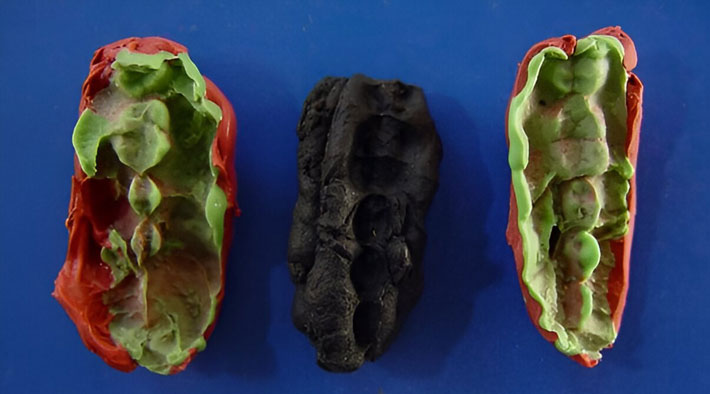 MERSIN, TURKEY—Cosmos Magazine reports that a team of researchers led by Emrah Kirdök of Mersin University has analyzed three pieces of 10,000-year-old birch pitch, a sticky substance made by heating birch bark to form a glue-like substance. These pieces of birch pitch were recovered from Huseby Klev, a Mesolithic hunter-gatherer site in western Sweden. The researchers compared the ancient chewed birch pitch with modern samples, ancient human dental plaque, and a 6,000-year-old sample of chewed tar. They found higher levels of bacteria associated with poor dental health in the 10,000-year-old samples, even though chewing birch pitch may have provided some antiseptic and medicinal benefits. Using their teeth for gripping, cutting, and tearing may have exposed the hunter-gatherers to a wide variety of damaging microorganisms, the researchers suggest. DNA from hazelnut, apple, mistletoe, red fox, grey wolf, mallard, limpet, and brown trout were also identified. These materials, in the form of food, furs, and bone tools, may have been chewed by the people before they chewed the birch pitch. Read the original scholarly article about this research in Scientific Reports. To read about DNA embedded in another piece of chewed birch pitch, go to "Around the World: Denmark."
MERSIN, TURKEY—Cosmos Magazine reports that a team of researchers led by Emrah Kirdök of Mersin University has analyzed three pieces of 10,000-year-old birch pitch, a sticky substance made by heating birch bark to form a glue-like substance. These pieces of birch pitch were recovered from Huseby Klev, a Mesolithic hunter-gatherer site in western Sweden. The researchers compared the ancient chewed birch pitch with modern samples, ancient human dental plaque, and a 6,000-year-old sample of chewed tar. They found higher levels of bacteria associated with poor dental health in the 10,000-year-old samples, even though chewing birch pitch may have provided some antiseptic and medicinal benefits. Using their teeth for gripping, cutting, and tearing may have exposed the hunter-gatherers to a wide variety of damaging microorganisms, the researchers suggest. DNA from hazelnut, apple, mistletoe, red fox, grey wolf, mallard, limpet, and brown trout were also identified. These materials, in the form of food, furs, and bone tools, may have been chewed by the people before they chewed the birch pitch. Read the original scholarly article about this research in Scientific Reports. To read about DNA embedded in another piece of chewed birch pitch, go to "Around the World: Denmark."
Chewed Birch Pitch May Reflect Hunter-Gatherers’ Dental Health
